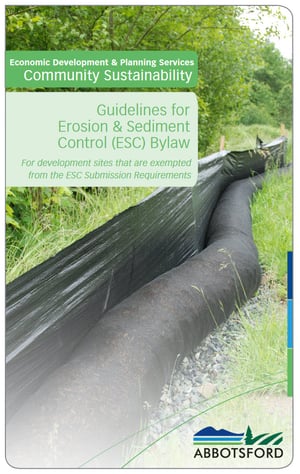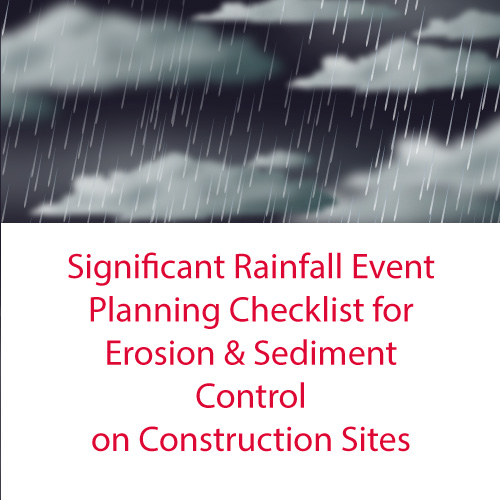How does sediment affect stormwater infrastructure and streams?
Without proper control practices, construction activities can contribute large amounts of sediment to local drainage systems, including streams and storm sewers.
Sediment causes water conveyance issues, which can increase flood risks. Storm sewers or channels can have a reduced capacity due to sediment accumulation which may result in storm water not being able to discharge adequately from the area. The City spends hundreds of thousands of dollars each year removing accumulated sediment from storm sewers, ditches and streams.
Sediment in streams also causes numerous problems to aquatic life, including salmon, plants and insects:
- Fish are impacted through the reduction in food (insects), infilling of gravel spawning areas, reduced feeding (from inability to visually target their prey), increased stress (decreased survival rates due to a number of factors such as reduced growth rates and decreased immune system), and gill abrasion;
- Extended periods of poor water quality in a stream may reduce the production of plants due to reduced sunlight;
- Insect production declines due to a reduction in their food (plants), loss of habitat (many like to live in gravel, which would be covered by sediment), and impaired feeding (sediment clogs their filter feeding mechanisms).

Best Management Practices (BMPs)
(for exempted sites)
The existing contour of the land and the existing vegetative cover serve to intercept, convey or store stormwater. Most construction activities alter the existing state of the land and this may result in erosion when rainwater encounters the exposed soils.
There are techniques that you can employ on your site to control the erosion and sediment problems you may encounter. These techniques have been identified as “Best Management Practices” (BMPs). Erosion control techniques prevent erosion from occurring within the construction site through placing materials (e.g., poly tarps, straw) over exposed soils, whereas sediment control techniques capture eroded sediments or sediment-laden water and prevent them from leaving the site. Erosion control is more effective, less expensive and requires less maintenance. Sediment control is very difficult, as many areas have till soils with a high fraction of clay, which can take years to settle out of water. As such, you should not disturb more of the construction site than is absolutely necessary. In order to comply with the ESC Bylaw, and other pertinent legislation, the property owner/agent is responsible for ensuring that BMPs are implemented on site. Acceptable BMPs include:
Required Best Management Practices
- Clear only the areas necessary (leave vegetation in areas that don’t require disturbance).
- Establish a Stabilized Entry/Exit Point.
- Protect the perimeter of the site.
- Divert up-slope water around the work site (keep clean water clean).
- Roughen exposed soils.
- Temporarily stabilize disturbed earth.
- Create temporary sediment detention facilities onsite.
- Install inlet protection measures at all storm system inlets.
- Place soil piles upslope of the perimeter protection and cover with plastic sheeting or erosion control blankets.
- Dewater to a contained part of the site and allow it to infiltrate into the soil.
- Install roof downpipes as soon as practicable after the roof is laid.
- Ensure that all control measures are maintained in good working order.
- Re-vegetate or otherwise permanently stabilize the site.
FAQ's
Q: When do I have to have everything installed?
A: Before your first (footing forms) inspection. If appropriate ESC control works are not in place, the inspector may refuse your forms inspection. You will be required to install your erosion and sediment control works before any further construction can take place.

Q: Who is responsible on big, multi-builder sites that have an ESC Plan and an ESC Supervisor hired?
A: The property owner/agent is responsible for the quality of water leaving the lot you are working on. You must not discharge muddy water to street or lawn drains. You must implement all applicable BMPs. You are required
to keep the street and sidewalk in front of your lot clean by making sure material isn’t tracked out and by sweeping or shoveling. DO NOT hose material down the drains. You must be aware of the weather conditions and take appropriate actions in periods of excessive rain.
Q: When and how will this Bylaw be enforced?
A: This Bylaw is now in effect. Builders that continue to work without proper ESC controls will be refused inspections and may face extra fees for work without inspection, street cleaning, and re-inspection.
Q: Must the BMPs be implemented on every site?
A: Yes, unless it can be deemed that they are unnecessary to meet the discharge requirements specified in the ESC Bylaw.




